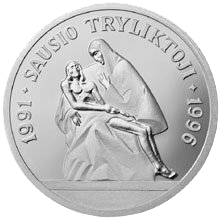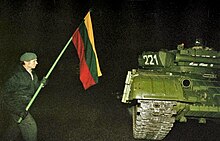January events in Lithuania in 1991

January events in Lithuania 1991 describes the events of January 13, 1991 in Vilnius , when the armed forces of the Soviet Union (USSR), special units of the Soviet Interior Ministry ( OMON ), the State Security Committee of the USSR ( KGB ), as well as their special unit ALFA an ultimately failed coup to restore the political power of the Soviet Union in the Republic of Lithuania . During these events and the protection of the Lithuanian television tower Vilnius as a means and symbol of Lithuania's freedom and independence from the Soviet Unionfourteen people were killed and more than 1,000 people injured. The unarmed Lithuanians were partly overrun by tanks of the Soviet Army and partly shot.
Putsch and crackdown
The Soviet Union was not ready to accept the independence of the Baltic states ( Singing Revolution ) during the perestroika period and reacted in the period from April to May 1990 with a raw material blockade, which paralyzed the Lithuanian economy. On January 10, 1991, General Secretary Mikhail Gorbachev called on Lithuania's acting head of state, Vytautas Landsbergis, to recognize the Soviet constitution and thereby renounce independence.
On January 13, 1991, a Sunday, forces loyal to Moscow attempted a coup with the support of the Soviet military and special forces. A total of 14 unarmed civilians defending the parliament and the television tower in Vilnius were killed, and over 1,000 were injured. The coup failed. In response to the bloody events, a referendum was held on February 9, 1991 . With a turnout of 85%, 90.5% of voters voted for an independent Lithuania. The Icelandic parliament was the first in the world to decide to recognize the Republic of Lithuania as an independent state.
Gorbachev declared the referendum invalid and the television building remained occupied until further notice. Seven border guards were killed in an attack by OMON troops on a Lithuanian border post.
After the attempted coup by hardliners in Moscow in August 1991 failed, Lithuania's independence was recognized by over 90 states within a very short time.
The violence of the January events was in clear contrast to the non-violence of the previous independence process and made it clear that the suppression mechanisms of the Soviet Union were still effective during the period of perestroika and glasnost . Ultimately, the demonstrations in Lithuania, as in the entire Baltic region, led to the independence of the states there. Today all three Baltic states belong to the European Union and NATO .

Fatalities
The victims were:
- Loreta Asanavičiūtė (* 1967)
- Virginijus Druskis (* 1969)
- Darius Gerbutavičius (* 1973)
- Rolandas Jankauskas (* 1969)
- Rimantas Juknevičius (* 1966)
- Alvydas Kanapinskas (* 1952)
- Algimantas Petras Kavoliukas (* 1939)
- Vytautas Koncevičius (* 1941)
- Vidas Maciulevičius (* 1966)
- Titas Masiulis (* 1962)
- Alvydas Matulka (* 1955), heart attack
- Apolinaras Juozas Povilaitis (* 1937)
- Ignas Simulionis (* 1973)
- Vytautas Vaitkus (* 1943)
Commemoration
In the same year, on December 18, 1991, the Lithuanian parliament decided on the foundation of the commemorative medal of January 13 (lit: Sausio 13-osios atminimo medalis ). The Republic of Lithuania honors national and foreign personalities who have supported the struggle for the restoration of Lithuanian independence. Among the first to be awarded the medal were Sigitas Tamkevičius , then auxiliary bishop in Kaunas, Felicija Nijolė Sadūnaitė and Mstislaw Rostropovich .
Numerous monuments and memorials were erected for the victims of the January events, streets and squares were named after them.
Work-up
In August 1999, a court in Vilnius found six people guilty of crimes committed by the Soviet military .
In connection with the events of Lithuania, the former KGB officer Mikhail Golowatov is wanted as a war criminal with a European arrest warrant . Golowatow was arrested on July 14, 2011 at Vienna International Airport . However, because the information provided by Lithuania was “too vague” according to the Vienna Foreign Ministry , he was released after only 24 hours. This led to diplomatic resentments between Lithuania and Austria.
Another trial against survivors of those responsible for the violence opened in Vilnius in January 2016 and ended in 2019 with the sentencing of 67 people living in Russia, Ukraine and Belarus.
Denial of Soviet aggression
In 2012 socialist Algirdas Paleckis was convicted by the Lithuanian Supreme Court for saying that Lithuanians shot their own people .
Web links
- Memorial page of the Lithuanian parliament on the struggle for freedom
- ARD Tagesschau from January 13, 1991
Individual evidence
- ↑ About. In: Sausio 13-oji. Accessed January 13, 2021 .
- ↑ Lietuvos Respublikos Aukščiausiosios Tarybos Prezidiumas: Įsakas dėl apdovanojimo Sausio 13-osios atminimo medaliu (Lithuanian), accessed on October 1, 2019.
- ↑ Vilnius Blood Sunday: Lithuanian calls for Gorbachev's Nobel Peace Prize to be revoked , RIA Novosti from January 13, 2012, viewed December 7, 2012
- ↑ Release of ex-KGB officer: Latvia also protests , Wiener Zeitung from July 19, 2011, viewed July 19, 2011.
- ^ Rudolf Hermann: Lithuania struggles with its past. Historical process of the Moscow military intervention of 1991 . In: Neue Zürcher Zeitung, February 4, 2016, p. 5.
- ↑ LRT from September 15, 2019
- ↑ Lithuanian former journalist says country tried to deny speech, send him to prison , The National Press Club, June 7, 2012
- ↑ Aukščiausiasis Teismas paskelbė, kad Algirdas Paleckis pagrįstai nuteistas baudžiamojoje byloje dėl Sausio 13-osios nusikaltimų neigimo


